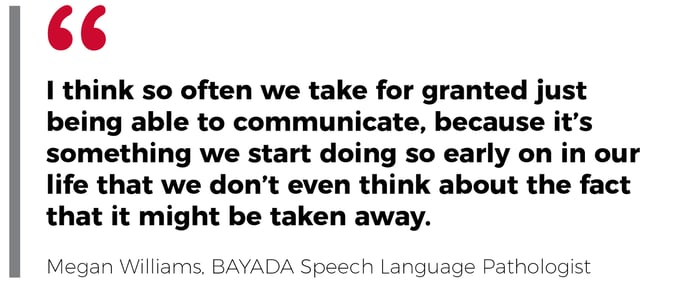To communicate in the ways we can: unbound, unlimited—to pick and choose the words that best represent what we’re thinking, to put them in a grammatical order that relays the meaning to someone else—is fundamentally human. But for those of us who have no trouble communicating, it’s important to remember that there’s about three million Americans who can’t quite relate to our ease. Why? They have a stutter.

What is stuttering?
Stuttering, or disfluency, is a speech disorder that affects both children and adults. It's characterized by repetitions (repeating sounds, syllables, or words); prolongation of sounds; and blocks, interruptions and/or halts in speech. Someone who stutters can exhibit one, or all, of these issues when trying to communicate.
Types of stuttering
- Developmental: This is most frequently found in children younger than five years old. It can naturally occur as their speech and language facilities begin to develop—and, generally, resolves without any need for medical treatment.
- Neurogenic: This type is distinguished by signal abnormalities between the brain and the nerves or muscles used to speak.
- Psychogenic: Contrary to neurogenic, which deals with a motor issue, psychogenic originates in the frontal lobe, which governs thinking and reasoning.
Causes of stuttering
In order to discuss the causes of stuttering, let’s break it down by type of stutter:
Developmental stuttering
The causes of stuttering for developmental cases can include:
- Natural occurrence during a child’s language acquisition phase
- Family history of stuttering (thus an inherited abnormality in the temporal lobe)
 Stuttering in toddlers is something that BAYADA Speech Language Pathologist (SLP), Megan Williams (right), sees often.
Stuttering in toddlers is something that BAYADA Speech Language Pathologist (SLP), Megan Williams (right), sees often.
“Under three and a half, it’s actually a pretty typical behavior as they’re learning to speak and use language. That coordination can cause stuttering, because their little mouths don’t move as fast as their brains sometimes. They’re just learning so much!”
She receives calls from concerned parents of toddlers all the time. “They call and say, ‘Oh my gosh, they started stuttering!’”
She tells parents to not draw any attention to it, especially if the child is under the age of three. Sometimes pointing it out can inadvertently create an anxiety around the stutter and make it worse.
“I’ll say, ‘Everything is fine. Don’t let them know that you’re drawing attention to it. Don’t tell them they have a stutter. Just give them little tips and things like that, and try to keep an eye on it. You can repeat back to them, while modeling it properly. But don’t let them know that you’re trying to show them how to say it.’”
Many cases of developmental stuttering don’t last long and resolve on their own, if they’re a naturally occurring part of a child’s development. Once in a while, Megan sees a school-age child with a true stutter or disfluency issue. She finds that, in some cases, they are incorrectly identified as a speech or language impairment, or even a psych issue.
“Sometimes,” she says, “it’s just about really identifying the issue and treating it as indicated.”
With a stutter, once it’s identified, it can get worse before it gets better. Stutters can be exacerbated by anxiety surrounding them. If you realize when it’s going to happen and get nervous about it, it can make the stutter occur more frequently. That can make it more severe.
Some children who stutter become adults who stutter, but with treatment from a speech language pathologist, those symptoms can be managed. Plenty of people with disfluencies go on to public jobs. Famously, Joe Biden stutters—but he doesn’t let that stop him from making speeches or running for office, nor should he.
It’s not always the case that an adult who stutters grew up with it. Adult onset stuttering or acquired stuttering or disfluency is something that’s not as commonly known. There are a lot of cases that start later in life and a variety of causes for those, as well.
Neurogenic stuttering
The causes of stuttering for neurogenic cases can include:
- Stroke (with or without aphasia)
- Transient Ischemic Attack (TIA)
- Traumatic Brain Injury (TBI)
- Degenerative diseases like Parkinson’s or multiple sclerosis (MS)
- Head trauma
- Tumors, cysts, or other neoplasms
Psychogenic stuttering
The causes of stuttering for psychogenic cases can include:
- Stress
- Severe emotional trauma, or PTSD
- Depression
Sometimes the causes of stuttering are idiopathic, meaning that the cause is unclear. Part of the job of an SLP is to figure out what the problem actually is, what’s making the stutter happen, and when it’s at its worst. Identifying the struggle and training a person through it is part of how a speech language pathologist treats stuttering.
The Do’s and Don'ts of interacting with someone who stutters
- Do whatever you can do to help reduce the stress and anxiety about the stutter. Be patient!
- Don’t interrupt or fill-in-the-blank.

- Do ask them what’s helpful for you to do if they get caught on a word. Some people might want you to jump in and give them that word they’re trying to get. Many people would rather you give them time to work it out on their own. Everyone’s different. By asking, you’re giving them the power and security to say, “This is what works for me, and this is how you can help me.”
- Don’t rush them to get their point across quicker.
- Do give them time during communication exchanges to use and practice the strategies they’ve learned.
- Don’t draw attention to the stutter when it does occur.
- Do offer to help them practice if they’re in therapy. A stutterer may not feel comfortable asking. After all, it’s easier to take someone up on an offer than to ask for help.
Find out more about BAYADA's in-home speech therapy offerings



Let Us Know What You Thought about this Post.
Put your Comment Below.